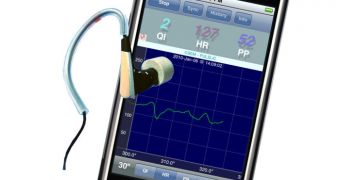A group of scientists has developed a new device for the iPhone, which can be used to keep track of your heart beats while on the go. The sounds are sent through headphones, so you can listen to the heart like you are listening to music.
The system is rather basic, but it allows for accurate monitoring, which could prove useful in a variety of situations. The final prototype for the tool was developed by Swiss technology-transfer company CSEM, based on a machine created for astronauts.
The Pulsear device will work rather simply. It uses an infrared laser to measure the pulse within the ear. Data are sent back to a small light-sensitive diode, which then transmits them to a small attachment that goes into the phone.
The heart rate is displayed on the screen similarly to how it shows on an electrocardiogram (EKG). These readings are generally taken via cumbersome chest belts, that pick up the signals the heart emits from a number of “vantage points.”
“A lot of people listen to music while they exercise and a lot of people find the [chest] belts uncomfortable, so we thought it made sense to try to measure heart rate through the ear,” explains CSEM expert Dr Andrea Ridolfi.
This is not the first time the company tries to develop such a system. A previous attempt was unsuccessful because the technology to do so was not available at the time.
The much-needed breakthrough came after the company designed and developed a complex chest sensor, which now helps keep track of the levels of oxygen in the blood of astronauts.
This device was created for the Long Term Medical Survey system operated by the European Space Agency (ESA).
“We wanted something small, compact and unobtrusive for physiological research,” explains the senior engineer on the ESA LTMS project, Michel Lazerges.
After creating the oxygen sensor, CSEM investigators realized that the technology could be “recycled” to finally produce the in-ear heart monitor.
The final prototype was made possible with grants secured under the ESA Technology Transfer Program’s ‘Transfer Demonstrator’ initiative.
Future iterations of the tool could be used to keep track of other vital parameters as well, officials from the company say, which would open up a host of possible medical applications for Pulsear.

 14 DAY TRIAL //
14 DAY TRIAL //